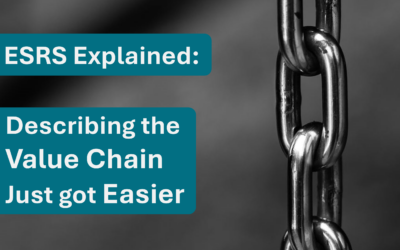What is ESRS G1 Business Conduct and its Main Objective?
The objective of ESRS G1 Business Conduct is to set forth specific disclosure requirements that enable users of a company’s sustainability statements to thoroughly understand the company’s strategies, approaches, and performance concerning business conduct. This standard is crucial for ensuring transparency and accountability in how a company manages its ethical behavior and governance across several core areas.
How to know what to disclose for your company in ESRS G1 Business Conduct?
Note! All the 8 sections of disclosures below most probably do not have to be disclosed depending on what’s material for the company concerning ESRS G1 Business Conduct.
Use the Mentcon model for ESRS. The logic of what to disclose is included in the Mentcon model for the ESRS web-app to make it easy for companies to know what to disclose. This is made based on the draft of ID 177 – Links between AR16 and Disclosure requirements, and will be updated in the Mentcon model if any changes are made in the final version.
ESRS G1 Business Conduct Disclosure Requirements Summarized
The disclosure requirements G1 standard are divided into eight sections:
ESRS 2 G1 GOV-1 – The Role of the Administrative, Supervisory, and Management Bodies
The company must disclose the role and expertise of its administrative, supervisory, and management bodies concerning business conduct. This requirement provides insight into how these bodies are involved in overseeing and guiding the company’s approach to business conduct and ethics.
Key Elements to Disclose in ESRS G1 GOV-1:
- Role in Business Conduct: Outline the specific responsibilities and roles of the administrative, management, and supervisory bodies in relation to business conduct. This includes how they oversee, guide, and manage the company’s policies and practices concerning ethical conduct and compliance.
- Expertise on Business Conduct: Describe the expertise these bodies have regarding business conduct matters. This might include their experience, training, or specific knowledge areas that enable them to effectively oversee business conduct policies and practices.
ESRS 2 G1 IRO-1 – Description of the Processes to Identify and Assess Material Impacts, Risks, and Opportunities
The company needs to provide a description of the processes used to identify and assess material impacts, risks, and opportunities concerning business conduct. This helps in understanding how the company evaluates and manages the ethical aspects of its operations.
Key Elements to Disclose in ESRS G1 IRO-1:
- Criteria Used in the Process: Provide details about the criteria used in the process of identifying material impacts, risks, and opportunities. This includes factors such as location, activity, sector, and transaction structure. It helps stakeholders understand the depth and scope of the company’s assessment process.
- Identification Process: Explain how the company identifies potential business conduct issues and how it assesses their materiality. This gives insight into the company’s due diligence processes and risk management practices in the realm of business conduct.
G1-1 – Business Conduct Policies and Corporate Culture
The company must disclose its policies on business conduct and how it fosters its corporate culture. This requirement aims to provide an understanding of how the company addresses its material impacts, risks, and opportunities related to business conduct and promotes ethical behavior within the organization.
Key Elements to Disclose in ESRS G1-1:
- Corporate Culture: Describe how the company establishes, develops, promotes, and evaluates its corporate culture. This includes the values and principles that guide behavior within the company and how these are communicated and reinforced.
- Mechanisms for Reporting Concerns: Outline the mechanisms in place for identifying, reporting, and investigating concerns about unlawful behavior or violations of the company’s code of conduct. Include whether these mechanisms are available to both internal and external stakeholders.
- Anti-Corruption and Anti-Bribery Policies: If the company has policies on anti-corruption or anti-bribery in line with the United Nations Convention against Corruption, describe them. If not, state whether there are plans to implement such policies and the timetable for implementation.
- Whistleblower Protection: Detail the measures in place to protect whistleblowers, including:
- Internal whistleblower reporting channels and whether training is provided to workers.
- Measures to protect against retaliation in accordance with Directive (EU) 2019/1937.
- If there are no whistleblower protection policies, state this and provide plans and timelines for implementation if applicable.
- Investigating Business Conduct Incidents: Describe whether the company has procedures to promptly, independently, and objectively investigate business conduct incidents, including corruption and bribery.
- Animal Welfare Policies: If applicable, disclose whether the company has policies concerning animal welfare.
- Training on Business Conduct: Describe the company’s training policy on business conduct, including the target audience, frequency, and depth of coverage.
- Functions at Risk: Identify the functions within the company that are most at risk of corruption and bribery, indicating where potential vulnerabilities might exist.
G1-2 – Management of Relationships with Suppliers
The company should provide information about how it manages relationships with its suppliers and the impacts on its supply chain. This includes describing policies that ensure fair behavior with suppliers and prevent late payments, particularly to small and medium-sized enterprises (SMEs).
Key Elements to Disclose in ESRS G1-2:
- Approach to Supplier Relationships: Describe the company’s approach to managing relationships with its suppliers, taking into account the risks related to the supply chain and impacts on sustainability matters. This includes considerations for fair treatment and ethical sourcing.
- Social and Environmental Criteria: Explain whether and how the company incorporates social and environmental criteria in the selection and evaluation of suppliers. This shows the company’s commitment to responsible sourcing practices.
- Policy on Late Payments: Provide a description of the company’s policy to prevent late payments, specifically to SMEs. This includes measures and practices to ensure timely payments and support the financial health of smaller suppliers.
G1-3 – Prevention and Detection of Corruption and Bribery
The company must provide information about its systems to prevent, detect, investigate, and respond to allegations or incidents of corruption and bribery, including related training programs. This helps in understanding the company’s commitment to ethical practices and compliance with anti-corruption laws.
Key Elements to Disclose in ESRS G1-3:
- Procedures for Prevention and Detection: Describe the procedures in place to prevent, detect, and address allegations or incidents of corruption and bribery. This includes detailing how the company systematically prevents these unethical practices.
- Investigation Independence: Indicate whether the investigators or the investigating committee are separate from the management involved in the matter. This ensures that investigations are conducted impartially and without conflict of interest.
- Reporting Outcomes: Outline the process for reporting outcomes of investigations to the administrative, management, and supervisory bodies. This highlights transparency and accountability in handling incidents of corruption and bribery.
- Communication of Policies: Explain how the company communicates its anti-corruption and anti-bribery policies to relevant stakeholders to ensure understanding and accessibility of these policies.
- Training Programs: Provide details about the nature, scope, and depth of anti-corruption and anti-bribery training programs offered or required by the company. Include:
- The percentage of functions at risk covered by these training programs.
- The extent of training provided to members of the administrative, management, and supervisory bodies.
- Lack of Procedures Disclosure: If the company has no procedures in place, it must disclose this fact and, if applicable, state plans to adopt such procedures and the timetable for implementation.
G1-4 – Incidents of Corruption or Bribery
The company should disclose information on incidents of corruption or bribery during the reporting period. This disclosure aims to provide transparency on how the company deals with such incidents and the outcomes.
Key Elements to Disclose in ESRS G1-4:
- Convictions and Fines: Disclose the number of convictions and the amount of fines for violations of anti-corruption and anti-bribery laws. This shows the direct legal and financial consequences the company has faced due to unethical practices.
- Actions Taken: Detail any actions taken to address breaches in anti-corruption and anti-bribery procedures and standards. This indicates the company’s efforts to correct and prevent future incidents.
- Optional Disclosure of Incidents: The company may choose to disclose additional information, including:
- The total number and nature of confirmed incidents of corruption or bribery.
- The number of employees dismissed or disciplined for corruption or bribery-related incidents.
- The number of incidents involving contracts with business partners that were terminated or not renewed due to violations.
- Details of public legal cases regarding corruption or bribery brought against the company and its employees, including the outcomes of these cases.
- Value Chain Involvement: Disclosures should include incidents involving actors in the value chain only where the company or its employees are directly involved.
G1-5 – Political Influence and Lobbying Activities
The company must provide information on its activities and commitments related to exerting political influence, including lobbying activities. This ensures transparency regarding how the company engages with political processes and influences policy-making.
Key Elements to Disclose in ESRS G1-5:
- Oversight of Activities: If applicable, identify the representatives in the administrative, management, and supervisory bodies responsible for the oversight of political influence and lobbying activities. This shows governance over these activities.
- Political Contributions: Provide details on financial or in-kind political contributions, including:
- The total monetary value of contributions made directly or indirectly, aggregated by country or geographical area and type of recipient/beneficiary.
- How the monetary value of in-kind contributions is estimated.
- Lobbying Activities: Describe the main topics covered by the company’s lobbying activities and its main positions on these topics. Explain how these activities interact with the company’s material impacts, risks, and opportunities as identified in its materiality assessment.
- Transparency Register: If the company is registered in the EU Transparency Register or an equivalent national register, provide the name of the register and the company’s identification number in the register.
- Previous Public Administration Roles: Disclose information about any members of the administrative, management, and supervisory bodies who held comparable positions in public administration or regulatory bodies in the two years preceding their current appointment.
G1-6 – Payment Practices
The company should provide information on its payment practices, especially with respect to late payments to small and medium enterprises (SMEs). This disclosure sheds light on the company’s financial practices and their impact on suppliers.
Key Elements to Disclose in ESRS G1-6:
- Average Payment Time: Disclose the average time the company takes to pay an invoice from the date when the contractual or statutory term of payment starts to be calculated, expressed in days. This indicates the company’s efficiency and reliability in fulfilling its financial obligations.
- Standard Payment Terms: Describe the company’s standard payment terms, including the number of days by the main category of suppliers and the percentage of payments aligned with these standard terms. This shows how the company sets and adheres to payment agreements.
- Legal Proceedings: Provide information on the number of legal proceedings currently outstanding for late payments. This gives insight into potential disputes and the company’s compliance with payment obligations.
- Complementary Information: Include any additional information necessary to provide context. If the company has used representative sampling to calculate the average payment time, it should state this fact and briefly describe the methodology used. This ensures transparency and context for understanding the company’s payment practices.
Full list of disclosure requirements in ESRS G1 Business Conduct
Direct link to the topic ESRS G1 Business conduct in ESRS: Consolidated TEXT: 32023R2772 — EN — 22.12.2023 (europa.eu)
Video of ESRS G1 Business Conduct (Educational)
This educational video was made for the draft of ESRS from the EU financed organization EFRAG who was responsible of creating the ESRS. We have not found any other video with qualitative information in English for ESRS G1 Business Conduct.
The minor changes made in the final version of ESRS G1 Business Conduct has not impacted this video’s relevance.
Read more in our FAQ section about ESRS G1 Business Conduct.






